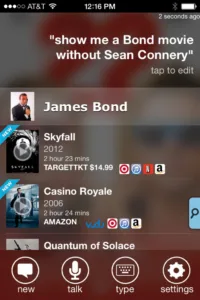Before the show, our reporter caught up with Rovi’s Charles Dawes to discuss the company’s presence at the show. We had heard at CES that Rovi was seeking to sell its DivX business, and this has now taken place. The company’s focus this year is on content discovery tools and advanced usability.
The problems facing the TV market today are content and audience fragmentation. There are many different ways and places to source content from and people expect a personalised service. “It’s not just about a single-view EPG”, said Dawes.
Making search easier is important, so Rovi is showing a new conversational voice command function (http://tinyurl.com/onxnp29). Rather than memorising a list of commands, users will be able to speak naturally to devices using the software. Filtering is also possible; for instance, a user could search for comedy films, then trim it down by asking which of them a specific actor appeared in. Further filtering would let them, for example, ask if any of the films have won awards.
Rovi has invested more than 500,000 hours into its voice search feature, to enable the natural language recognition. Because it is context-sensitive it can differentiate, for instance, between Chicago the film, Chicago the Broadway show, Chicago the band and sports teams from Chicago. It could also return the film Castaway if asked “What was the film with Tom Hanks stranded on an island?”
The new voice search feature is part of Rovi’s Personalised Discovery Solution: a set of services to help users to consume content. A predictive search and recommendation engine is also built in, as well as Rovi’s information database. The recommendation, said Dawes, uses Rovi’s metadata, which is collected by a 400-strong team in the USA and Europe.
A partnership was announced with Broadcom, to deliver the new Rovi Cloud offering. Rovi Cloud combines Rovi’s services into a cloud-based location, serving installed set-top boxes (STBs) and connected devices. A new service called the Media Platform – a modular technology platform to support Rovi’s products and services – will be part of the Cloud.
The Rovi Guide is Rovi’s current EPG, which will be enhanced soon to a “next-generation” version. It will be installed on Broadcom STBs and Arcelik TVs. At IBC, the Guide was being run on Broadcom’s BCM7445 UltraHD SoC. The new version is tailored to its users through functions such as their media consumption, searches and news.
Rovi also announced that Canal Digital Kabel, a cable TV provider in Norway, is to standardise the Rovi Search and Recommendation services for its ‘T-We’ entertainment portal.
At the Show
First we looked at the developments of Rovi’s guides and these now can combine broadcast and OTT content and Rovi is collecting data from 100 content providers (including HbbTV users). Driven by the needs of clients such as Samsung, the firm now has EPG data in 65 countries (70 later) and in 19 languages. Its next generation of EPG has been built on a single code base and can run on the web, on mobile devices and on TV as it supports web technologies being built on Ruby On Rails and HTML5.
We watched the demo of the new “semantic” voice technology and we were impressed (although some of the demos were not helped by the background noise). The ability of the system, which uses a remote voice recognition service (in the cloud), was impressive. Rovi has been working with UEI on a remote with a touchpanel and using BTLE to stream audio to a device.
Rovi can use any external speech recognition (ASRs such as Google) to decode voice commands which are then sent back to Rovi’s semantic layer which uses “big data” to try to understand context. For example, there are more queries about an actor who dies, so Rovi’s system tracks the twitter-sphere and Facebook to try to understand “hot” topics (my phrase for this is “the electronic zeitgeist” – Man. Ed.)
There are three pieces in the “equation” for Rovi, of content, the consumer and context. In terms of content, Rovi’s guides are very fine grained – for example it divides content into 600 sub-genres. That can actually help consumers to understand that they like a particular sub-genre or producer or actor. The system can start to understand the consumer by tapping into Facebook and can use patterns of viewing behaviour to start to develop personal context as well as global context.
Display Daily Comments
We were never quite sure we understood why Rovi bought DivX and Main Concept, so it was no real surprise that they went again. Rovi said that “Reach used to be important, but it’s now about engagement”. We wouldn’t disagree. What we liked about the Rovi semantic system was that each query clearly built on knowledge already gained. It recognises that if a question such as “when will Bayern play Schalke?” is about soccer, and not about theatrical plays. A follow up such as “and when do they play Cologne” would understand that the “they” refers to Bayern, still. That’s a big step forward.
I have been watching this kind of voice recognition for 30 years or more and this was definitely the best demonstration I have seen. There is a bit of a delay because of the processes involved, which might frustrate consumers today, but better broadband, faster ASRs and cloud systems will fix that pretty quickly. (BR)

